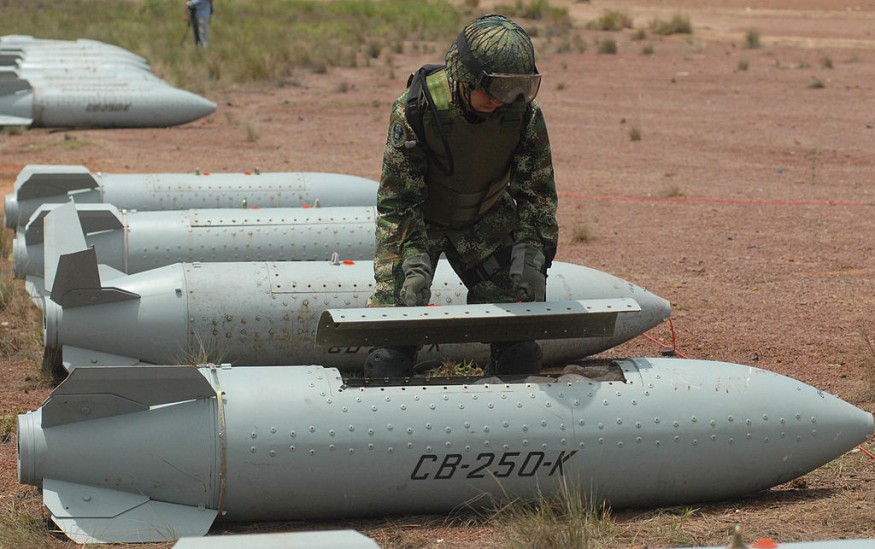
Humanitarian organizations claim that Russia has used the widely banned thermobaric weapons and cluster bombs against civilian targets in Ukraine. CNet reported that three people, including a child, were killed when a 220mm Uragan rocket dropped a cluster bomb in the Sochenko kindergarten in Okhtyrka, Ukraine.
Global human rights group Amnesty International said that Russia's strike "may constitute a war crime" for violating the prohibition on indiscriminate attacks and damaging a school. But what are thermobaric weapons and cluster bombs? Why are they explicitly prohibited from using them against military targets?
A Colombian Army bomb disposal expert opens the container of a Chilean-made CB-250K cluster bomb to extract the bomblets for destruction May 7, 2009 at the Marandua military base, Vichada department, Colombia.
What Are Cluster Bombs?
Cluster bombs have been widely banned around the globe since the Convention on Cluster Munitions went into effect in 2010. However, both Russia and Ukraine are not among the 110 countries that have signed the treaty, and neither does the United States.
According to the Bulletin of the Atomic Scientists, cluster bombs are weapons meant to break open in the air and scatter into smaller explosives called "bomblets" all over a wide area. These banned munitions have been widely criticized for their indiscriminate damage to people and the environment.
The International Committee of the Red Cross (ICRC) said that around 10% to 40% of the bomblets do not explode on contact, which poses a great risk for its destructive impact long after the fighting is done. Those unexploded bomblets are a risk to civilians, especially children who might mistake it for something to play with as it might appear to be small balls.
The Convention on Cluster Munitions reported that between 2010 and 2014, children below 18 years old have accounted for half of all cluster bombs casualties where victim details were known.
Two scholars studying the effect of cluster bombs in Lebanon wrote that fear of cluster munitions result in denied access to abundant natural resources, so populations move into fragile locations to avoid unexploded ordnances. However, this also leads to contamination of essential soil and water with toxic chemicals and causes acceleration of land degradation and ecosystem disruption.
Human Rights Watch said that both Russian-backed separatists and the Ukrainian government had used cluster bombs in the conflict in eastern Ukraine that started in 2014 that resulted in at least 31 deaths, including two children, between July 2014 and February 2015.
How Dangerous are Thermobaric Weapons?
Thermobaric weapons are not yet unequivocally banned, unlike cluster bombs. Marianne Hanson, an associate professor of International Relations from the University of Queensland, wrote in The Conservation that thermobaric weapons are deployed as rockets or bombs and release fuel or explosive charges that are toxic and ignite in contact with oxygen.
When this happens, it will create a high-temperature fireball and huge shockwave that sucks the air out of any living organism within the vicinity. Thermobaric weapons are destructive and effective in open spaces and urban areas. It also can penetrate bunkers and even underground locations to starve its occupants with oxygen.
It is so dangerous that there is very little that can protect humans from it. The Human Rights Watch cited a 1990 CIA report, which noted its effects in a confined space that could cause severe concussions, ruptured lungs and internal organs, and possibly blindness.
There has been an understanding between countries that even wars have limits. That means some weapons are legal, while some are not because they violate key principles of the humanitarian view.
RELATED ARTICLE : What Happens if Russia Bombs Ukraine's Chernobyl Nuclear Power Plant? Experts Explain Radioactive Risks
Check out more news and information on Tech & Innovation in Science Times.











